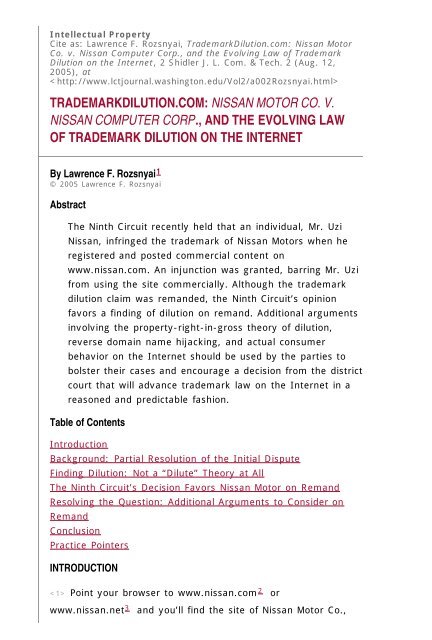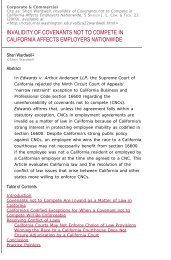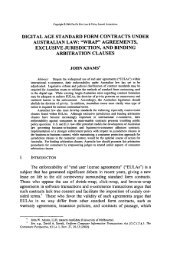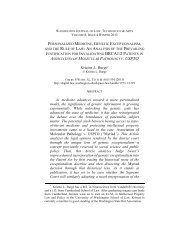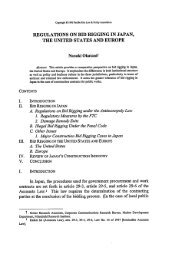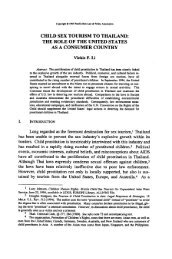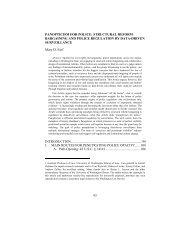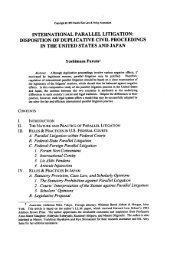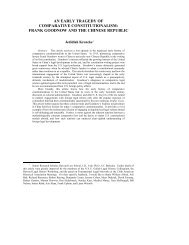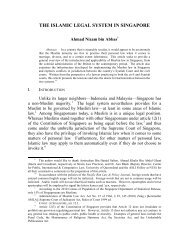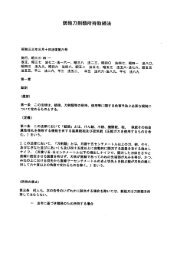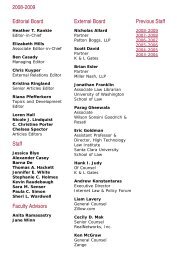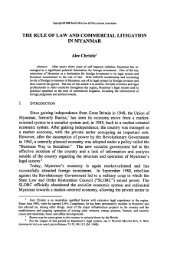Nissan Motor Co. v. Nissan Computer Corp., and the Evolving Law ...
Nissan Motor Co. v. Nissan Computer Corp., and the Evolving Law ...
Nissan Motor Co. v. Nissan Computer Corp., and the Evolving Law ...
You also want an ePaper? Increase the reach of your titles
YUMPU automatically turns print PDFs into web optimized ePapers that Google loves.
Both sides appealed <strong>the</strong> district court’s decision. In June2004, <strong>the</strong> Ninth Circuit affirmed <strong>the</strong> infringement judgment. Thecourt applied <strong>the</strong> well-known “Sleekcraft factors” of likelihood ofconfusion, <strong>and</strong> found that auto-related advertising was infringingbut non-auto-related content was not. 8 It reversed <strong>the</strong>injunction however, <strong>and</strong> struck down <strong>Nissan</strong> <strong>Motor</strong>’s attempt tosilence negative commentary about <strong>the</strong> lawsuit since such aninjunction would constitute a content-based restriction onspeech in violation of <strong>the</strong> First Amendment. The dilution claimwas rem<strong>and</strong>ed because <strong>the</strong> record lacked sufficient factsregarding <strong>the</strong> strength of <strong>the</strong> <strong>Nissan</strong> mark. 9FINDING DILUTION: NOT A “DILUTE” THEORY AT ALL Although <strong>the</strong> court was unable to issue a ruling on <strong>the</strong>dilution claim, it took a clear position on <strong>the</strong> applicable law. Itrelied heavily on two cases to construct its rule. First, from itsearlier decision in Avery Dennison v. Sumpton, it reiterated that“injunctive relief is available under <strong>the</strong> Federal TrademarkDilution Act [FTDA] if a plaintiff can establish that (1) its markis famous; (2) <strong>the</strong> defendant is making commercial use of <strong>the</strong>mark in commerce; (3) <strong>the</strong> defendant’s use began after <strong>the</strong>plaintiff’s mark became famous.” 10 Second, <strong>the</strong> <strong>Co</strong>urt followedMoseley v. V Secret Catalogue, Inc. by requiring <strong>the</strong> plaintiff toshow actual harm ra<strong>the</strong>r than likelihood of confusion to succeedon a dilution claim. 11 In applying <strong>the</strong> first part of <strong>the</strong> rule, <strong>the</strong> <strong>Co</strong>urt noted that“‘to be capable of being diluted, a mark must have a degree ofdistinctiveness <strong>and</strong> ‘strength’ beyond that needed to serve as atrademark.’” 12 In Avery Dennison, <strong>the</strong> <strong>Co</strong>urt emphasized thatdilution can be found for only those marks which have achieveda threshold level of famousness or prominence. 13 Factors ajudge should use to determine whe<strong>the</strong>r a mark is famousenough are provided in <strong>the</strong> FTDA <strong>and</strong> include <strong>the</strong> degree ofinherent or acquired distinctiveness, <strong>the</strong> channels of trade inwhich it is used, <strong>and</strong> <strong>the</strong> degree of recognition in its tradingareas <strong>and</strong> channels. 14 In <strong>Nissan</strong>, however, <strong>the</strong> factual recordwas clouded: <strong>Nissan</strong> <strong>Motor</strong> cited consumer surveys showing highdegrees of br<strong>and</strong> awareness, yet those surveys may have beenskewed; though <strong>Nissan</strong> <strong>Motor</strong>s had registered <strong>the</strong> <strong>Nissan</strong> markin 1959 <strong>and</strong> used that name to market vehicles in <strong>the</strong> UnitedStates since 1983, <strong>the</strong> same name has been used in o<strong>the</strong>rcommercial <strong>and</strong> even historic contexts. 15 Thus, <strong>the</strong> <strong>Co</strong>urtemphasized <strong>the</strong> strong degree of protection dilution <strong>the</strong>oryaffords, <strong>and</strong> <strong>the</strong> importance of applying it carefully. 16 On <strong>the</strong>second part of <strong>the</strong> rule, <strong>the</strong> <strong>Co</strong>urt completely skipped any
giving <strong>Nissan</strong> <strong>Motor</strong>s <strong>the</strong> benefit of <strong>the</strong> doubt. A third factor favoring <strong>Nissan</strong> <strong>Motor</strong> comes from Moseley,from which <strong>the</strong> Ninth Circuit borrows “‘direct evidence of dilutionsuch as consumer surveys will not be necessary if actual dilutioncan reliably be proved through circumstantial evidence—<strong>the</strong>obvious case is one where <strong>the</strong> junior <strong>and</strong> senior marks areidentical.’” 25 Since <strong>Nissan</strong> involves a dispute over an identicalmark, this statement allows <strong>the</strong> lower court to presume dilutionwithout a strong factual showing o<strong>the</strong>rwise. In summary, although <strong>the</strong> Ninth Circuit rem<strong>and</strong>ed <strong>the</strong>dilution claim, selected arguments from Avery Dennison <strong>and</strong>Moseley seem to favor a finding on rem<strong>and</strong> that NCC’s use of“nissan.com” diluted <strong>the</strong> famous mark of <strong>Nissan</strong> <strong>Motor</strong>.RESOLVING THE QUESTION: ADDITIONAL ARGUMENTS TO CONSIDERON REMAND Although <strong>the</strong> Ninth Circuit seems to favor <strong>Nissan</strong> <strong>Motor</strong>,<strong>the</strong> question of dilution is far from over. The following sectionsoutline fur<strong>the</strong>r influences on dilution law, <strong>and</strong> offer additionalarguments each party might use to bolster its case on rem<strong>and</strong>. Criticism of Schechter’s Dilution Theory: Serious concernshave been raised over <strong>the</strong> now-adopted Schechter model oftrademark dilution. 26 One commentator, Robert N. Klieger,argues that <strong>the</strong> property-right-in-gross model upsets <strong>the</strong>balance of two purposes of trademarks: first, to distinguishproducts <strong>and</strong> facilitate informed consumer decisions, <strong>and</strong> secondto create consumer loyalty <strong>and</strong> barriers against competitors. 27Fur<strong>the</strong>rmore, as Klieger continues, Schechter’s <strong>the</strong>oryencourages overinvestment in a trademark to <strong>the</strong> point ofcreating “intangible associations that add no real value” <strong>and</strong>stifles new entrants in even unrelated markets. 28 Klieger alsoexplains that courts since <strong>the</strong> 1930s have been quick to adoptSchechter’s overly protective dilution <strong>the</strong>ory, often with littleanalysis of <strong>the</strong>ir own: “courts continue to analyze dilution onlyin conclusory terms <strong>and</strong> have plainly accepted <strong>the</strong> invitation oftrademark rights in gross for at least some categories ofmarks.” 29 This trend will continue if <strong>the</strong> district court findsdilution with no analysis beyond that offered by <strong>the</strong> NinthCircuit. On rem<strong>and</strong>, NCC might apply <strong>the</strong>se economic arguments<strong>and</strong> argue that since <strong>Nissan</strong> <strong>Motor</strong> is not in <strong>the</strong> computerbusiness it will not benefit from silencing <strong>Nissan</strong> <strong>Co</strong>mputer<strong>Co</strong>rporation any more than it would from silencing o<strong>the</strong>rarguably diluting uses such as <strong>Nissan</strong> Thermos or <strong>Nissan</strong> Cup of
Noodles. In favor of <strong>Nissan</strong> <strong>Motor</strong>, however, is <strong>the</strong> weight ofrecent court rulings—most notably Moseley, which followed <strong>the</strong>Schechter doctrine <strong>and</strong> failed to adopt Klieger’s arguments. 30Trademark owners, whe<strong>the</strong>r future litigants or not, may benefitfrom a more thorough discussion of <strong>the</strong>se arguments by <strong>the</strong>district court. Reverse Domain Name Hijacking: Trademark attorneys mayrecognize <strong>Nissan</strong> as a classic case of reverse domain namehijacking. Mr. <strong>Nissan</strong> certainly does. 31 A domain nameregistrant is authorized by 15 U.S.C. § 1114(2)(D)(v) to sue anoverreaching trademark owner if <strong>the</strong> original registrant’s domainname has been suspended, disabled, or transferred. Few caseshave been heard on this <strong>the</strong>ory at <strong>the</strong> time of this writing,however, <strong>and</strong> none are directly on point. For example, <strong>the</strong> firstregistrant of “Barcelona.com” was able to defend from having<strong>the</strong> site transferred to <strong>the</strong> City <strong>Co</strong>unsel of Barcelona, Spain. 32The plaintiff won <strong>the</strong> case, however, because geographic namessuch as “Barcelona” can obtain trademark protection only if <strong>the</strong>yacquire secondary meaning. Additional cases apply §1114(2)(D)(v) as a way to rem<strong>and</strong> a dispute to <strong>the</strong> lower court,but fail to provide substantive rulings. 33 It is important to notethat <strong>the</strong> use of a personal name will not defend NCC. Atrademark utilizing <strong>the</strong> name of ano<strong>the</strong>r living person may onlybe used for non-commercial purposes, <strong>and</strong> no court has yet heldthat use on <strong>the</strong> Internet is any different. 34 As applied to <strong>the</strong> <strong>Nissan</strong> dispute, reverse domain namehijacking clearly favors NCC. It upholds <strong>the</strong> current first-come,first-served system of domain name registration <strong>and</strong> encouragesa company wishing to use its trademark as a web address toregister that name early. One may reasonably question whatpolicies are served by reserving dilution protection for acompany like <strong>Nissan</strong> <strong>Motor</strong>, which failed to register “nissan.com”<strong>and</strong> “nissan.net” before Mr. <strong>Nissan</strong> did. On <strong>the</strong> o<strong>the</strong>r h<strong>and</strong>,reverse domain name hijacking is mentioned nowhere in <strong>the</strong>Ninth Circuit opinion <strong>and</strong> perhaps need not be—previous casesindicate that 15 U.S.C. § 1114(2)(D)(v) is only appropriate as aremedy against an administrative decision of <strong>the</strong> UniformDomain Name Dispute Resolution Policy (UDRP), <strong>and</strong> not judicialdecisions. 35 Therefore, although reverse domain name hijackingmay currently be a remedy for improper “reverse hijacking”decisions made by <strong>the</strong> UDRP, Mr. <strong>Nissan</strong>’s argument may bemisplaced before <strong>the</strong> courts. As with <strong>the</strong> property-in-gross<strong>the</strong>ory, <strong>Nissan</strong> has <strong>the</strong> potential to clarify in what instancesreverse domain name hijacking can be successfully invoked. Actual <strong>Co</strong>nsumer Behavior on <strong>the</strong> Internet: The key
question <strong>Nissan</strong> raises—<strong>and</strong> what <strong>the</strong> Ninth Circuit ei<strong>the</strong>ravoided or missed—is how consumers actually use <strong>the</strong> Internetin commerce. Does “nissan.com” designate use in commerce, oris it simply <strong>the</strong> online analog of a physical address? The NinthCircuit has answered this question in ano<strong>the</strong>r case, holding that“[r]egistration of a trademark as a domain name, without more,is not a commercial use of <strong>the</strong> trademark.” 36 Moreover, <strong>the</strong>power of an Internet address to frustrate consumers in finding<strong>the</strong> desired mark—<strong>and</strong> thus diluting <strong>the</strong> trademark—has beenquestioned: “trademark law has always required reasonablenesson <strong>the</strong> part of consumers. . . . [W]hile <strong>the</strong> need to search for amark holder’s site [may be inconvenient,] this inconvenience [is]not cognizable.” 37 Reasoning by analogy to <strong>Nissan</strong>, with <strong>the</strong>widespread use of search engines, it is arguable how much aslightly different internet address actually dilutes a trademark in<strong>the</strong> mind of <strong>the</strong> consumer. Thus, <strong>the</strong> proper question may bewhe<strong>the</strong>r <strong>Nissan</strong> <strong>Motor</strong> has a right to use “nissan.com” ra<strong>the</strong>rthan “nissanusa.com” on <strong>the</strong> Internet any more than it has <strong>the</strong>right to be located on Main Street ra<strong>the</strong>r than on SecondAvenue in <strong>the</strong> real world. This argument would almost certainlyfavor NCC on rem<strong>and</strong>, <strong>and</strong> would fur<strong>the</strong>r compel a morereasoned decision by <strong>the</strong> district court.CONCLUSION The <strong>Nissan</strong> decision is generating criticism among thosewho think it goes too far in protecting large companies at <strong>the</strong>expense of small companies <strong>and</strong> individuals who are first to usea famous name on <strong>the</strong> Internet. Perhaps <strong>the</strong> only lesson from<strong>Nissan</strong> we can be certain of is <strong>the</strong> old adage “come to equitywith clean h<strong>and</strong>s.” It may be of little surprise that in this case,both parties arrived at court a bit soiled. <strong>Nissan</strong> <strong>Motor</strong> shared aname used in historic contexts, <strong>and</strong> failed to pursue o<strong>the</strong>rcommercial users of <strong>the</strong> name. Worse yet, it allowed Mr. <strong>Nissan</strong>to register “nissan.com” first! On <strong>the</strong> o<strong>the</strong>r h<strong>and</strong>, Mr. <strong>Nissan</strong>allowed arguably confusing auto-related content to appear onhis site. Then, in reaction to <strong>the</strong> initial lawsuit, he posteddisparaging commentary. Ei<strong>the</strong>r party could have improved itsposition by engaging in behavior that trademark law seeks topromote. Absent that, it should be remembered that instances inwhich David succeeds in slaying Goliath remain exceptional, notroutine. The <strong>Nissan</strong> dispute st<strong>and</strong>s as one of <strong>the</strong> early <strong>and</strong> veryinfluential cases on trademark dilution <strong>and</strong> related behavior on<strong>the</strong> Internet. Both <strong>the</strong> commercial <strong>and</strong> Internet communities willbe looking to <strong>the</strong> district court for a well reasoned opinion in <strong>the</strong>hopes that <strong>the</strong>se policies continue to take shape in a predictable
manner.PRACTICE POINTERS
Kendall Bodden, Everett Fruehling, Rose Hagan, BobGomulkiewicz, Sean O’<strong>Co</strong>nnor, <strong>and</strong> Jane Winn forproviding me with helpful feedback on this article.2. www.nissan.com (last visited June 9, 2005).3. www.nissan.net (last visited June 9, 2005).4. <strong>Nissan</strong> <strong>Motor</strong> <strong>Co</strong>. v. <strong>Nissan</strong> <strong>Co</strong>mputer <strong>Co</strong>rp., 378F.3d 1002, 1020 (9th Cir. 2004).5. Id. at 1006-08.6. <strong>Nissan</strong> <strong>Motor</strong> <strong>Co</strong>. Ltd. v. <strong>Nissan</strong> <strong>Co</strong>mputer <strong>Co</strong>rp., 231F. Supp.2d 977 (C.D.Cal. 2002).7. www.ncchelp.org (last visited June 6, 2005).8. <strong>Nissan</strong>, 378 F.3d at 1018-19 (citing AMF Inc. v.Sleekcraft Boats, 599 F.2d 341, 346 (9th Cir.1979)).9. Id. at 1020.10. Id. at 1010 (quoting Avery Dennison <strong>Co</strong>rp. v.Sumpton, 189 F.3d 868, 873-74 (9th Cir. 1999)).11. Id. at 1010 (citing Moseley v. V Secret Catalogue,Inc., 537 U.S. 418, 433-34 (2003)). Note that<strong>Co</strong>ngress is currently considering changing <strong>the</strong>st<strong>and</strong>ard in 15 U.S.C. § 1125 from actual harm tolikelihood of confusion. See Trademark DilutionRevision Act of 2005, H.R. 683, 109th <strong>Co</strong>ng. (2005).12. Id. at 1013 (quoting Avery Dennison, 189 F.3d at876).13. See Avery Dennison, 189 F.3d at 874-76.14. 15 U.S.C. § 1125(c). But see comment regardingproposed legislation supra note 8.15. <strong>Nissan</strong>, 378 F.3d at 1014.16. See J. Thomas McCarthy, McCarthy on Trademarks<strong>and</strong> Unfair <strong>Co</strong>mpetition § 24:70 (4th ed. 2004)(additional discussion on <strong>the</strong> dilution doctrine).17. <strong>Nissan</strong>, 378 F.3d at 1015.18. Id. at 1011 (quoting Avery Dennison, 189 F.3d at875). See also McCarthy, supra note 14, at §24:108.19. Robert N. Klieger, Trademark Dilution: The WhittlingAway of <strong>the</strong> Rational Basis for Trademark Protection,
58 U. Pitt. L. Rev. 789, 803-03, (1997) (citing FrankI. Schechter, The Rational Basis of TrademarkProtection, 40 Harv. L. Rev. 813 (1927) <strong>and</strong> Frank I.Schechter, The Historical Foundations of <strong>the</strong> <strong>Law</strong>Relating to TradeMarks (1925)).20. Mosley, 537 U.S. at 433 (rev’g. Ringling Bros.-Barnum & Bailey <strong>Co</strong>mbined Shows, Inc. v. Utah Div.of Travel Dev., 170 F.3d 449 (4th Cir. 1999)).21. <strong>Nissan</strong>, 378 F.3d at 1014 (quoting Avery Dennison,189 F.3d at 879).22. Avery Dennison, 189 F.3d at 877-78.23. Id. at 877.24. <strong>Nissan</strong>, 378 F.3d at 1013-14.25. Id. at 1015 (quoting Moseley, 537 U.S at 434).26. See, e.g. Klieger, supra note 16.27. Id. at 851-60.28. Id. at 862-63.29. Id. at 823 (footnotes omitted).30. Moseley, 537 U.S at 432.31. General Notes <strong>and</strong> FAQ (Frequently AskedQuestions) athttp://www.ncchelp.org/FAQ/faq.htm (“This is aclassic case of Reverse Domain Name Hijacking”)(last visited January 8, 2005).32. Barcelona.com, Inc. v. Excelentisimo Ayuntamientode Barcelona, 330 F.3d 617 (4th Cir. 2003).33. See, e.g.., Dluhos v. Strasberg, 321 F.3d 365, 368(3d Cir. 2003) (reversing dismissal for failure tostate a claim); Sallen v. <strong>Co</strong>rinthians LicenciamentosLTDA, 273 F.3d 14, 22 (1st Cir. 2001) (reversingdismissal for lack of jurisdiction).34. 15 U.S.C. § 1129. See also Tamarah Belczyk,Domain Names: The Special Case of PersonalNames, 82 B.U.L. Rev. 485, 505-12 (generaldiscussion, including mention of <strong>the</strong> <strong>Nissan</strong> dispute).35. See Dluhos, 321 F.3d at 373 (a domain nameregistrant has an affirmative cause of action in aUniform Domain Name Dispute Resolution Policyproceeding in cases of reverse domain name
hijacking); Sallen, 273 F.3d at 18 (domain nameregistrants have an affirmative action in federalcourt for a declaration of nonviolation of <strong>the</strong>Anticybersquatting <strong>Co</strong>nsumer Protection Act <strong>and</strong> for<strong>the</strong> return of <strong>the</strong> wrongfully transferred domainnames).36. Panavision Int'l L.P. v. Toeppen, 141 F.3d 1316,1324 (9th Cir. 1998) (quoting Panavision Int’l L.P. v.Toeppen, 945 F. Supp. 1296, 1303 (C.D.Cal. 1996)).37. HQM, Ltd. v. Hatfield, 71 F. Supp.2d 500, 508-09(D. Md., 1999) (citing Hasbro v. Clue <strong>Co</strong>mputing,Inc. 66 F. Supp. 2d 117, 124-25 (D. Mass. 1999).


